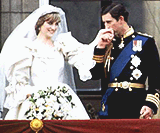Twenty years ago, a tall young woman with a shy smile flubbed
her lines before millions of people and became a superstar.
 |
| On
July 29, 1981, Lady Diana Spencer married Prince Charles and
became the Princess of Wales - and an international superstar.[AP] |
On July 29, 1981, Lady Diana Spencer took "Philip Charles
Arthur George" - she mangled the order of Prince Charles'
names during her vows - as her lawful wedded husband and entered
a family hidebound by practices no outsider could fathom.
It turned out to be much more than she bargained for. It also
turned out to be much more than they bargained for. But for the
media, it was a golden bonanza.
The Media Maelstrom
"The media changed dramatically in that decade of the 1980s,"
says Bob Houston, publisher of Royalty Monthly magazine.
"Diana was the spearhead of the American invasion of Britain,
the celebrity culture," says Houston.
"The British media is changing. It is becoming much more
celebrity-driven. And we had this No. 1 celebrity."
Diana, with her photogenic good looks, her sympathetic gestures
and an air of vulnerability, seemed much more relaxed than the
other royals, and much more accessible. She instantly clicked
with the public, who couldn't get enough of her.
"From the time she entered public life, Diana conveyed her
vulnerability with her eyes, her gestures, her speech, and her
touch," Sally Bedell Smith wrote in her book Diana in Search
of Herself. "Alongside her beauty, this evident fragility
made her a star."
Newspaper editors found the public was eager to lap up articles
about Diana, her clothes, her style, her public engagements, how
she was raising her two young sons. The '80s, says Houston, were
"the Decade of Diana."
Fairy Princess and Everywoman
Then, in June 1992, the carefully constructed fa?ade imploded
with the publication of Andrew Morton's Diana: Her True Story.
The book - written with Diana's cooperation - exposed the princess's
battles with bulimia and depression, and reviled Charles as an
unfaithful husband.
The revelations of Charles' relationship with a married woman,
Camilla Parker Bowles, sent the Prince of Wales' popularity plummeting.
But the revelations of Diana's problems did not decrease the public's
affection for her. It only increased their appetite to know more.
"Once the breadth and depth of her emotional struggle became
known," wrote Smith, "she struck an even deeper chord:
She became the fairy-princess version of the troubled everywoman."
The tabloid fodder kept coming: There was the royal separation,
the two camps' attempts to woo the public, the televised admissions
by both Charles and Diana of adultery. After the divorce became
final, in 1996, the media continued to follow Diana's every move.
And then, on Aug. 31, 1997, came the car crash in a Paris tunnel
that claimed her life.
The massive outpouring of public grief made the Windsors sit
up and take notice. "The amazing eruption of emotion over
her death got through to them that their world has had to change,"
says Houston.
Charles Gets the Message
The person who really got the message was Prince Charles, who
witnessed not only the public reaction but the grief of his own
sons, William and Harry.
"One of the great discussions, especially since Diana's
death, is, How does the House of Windsor modernize itself?"
says Houston. "They certainly learned the lessons from the
decade of Diana in terms of accessibility, shedding some of the
more pompous aspects of formality."
He says, "One of the greatest challenges the royal family
faces is to overcome the apathy, however, the future looks bright
for the royals. I think they've got a trump card in William."
(Agencies)
